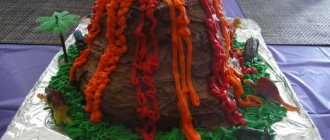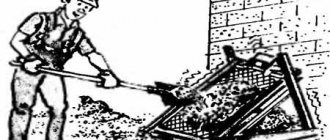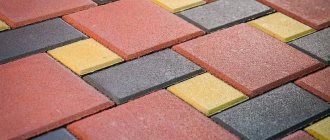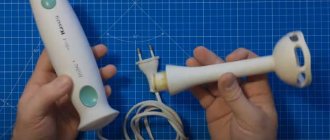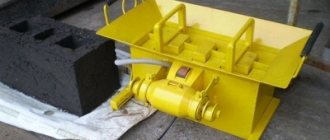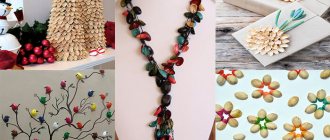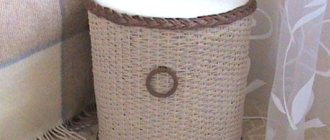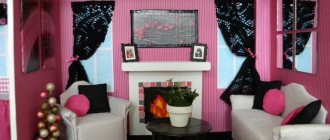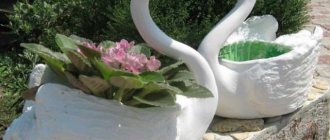A modern child is no longer interested in playing in a simple sandbox, which is not surprising given the appearance of kinetic sand (the word “kinetics”, translated from Greek, means “movement”). This is fine-grained sand, to which special synthetic components are added, thanks to which it acquires plasticity, does not stick to the skin, does not lose its shape and, most importantly, does not dry out. Today we will tell you how to make kinetic sand with your own hands and present various recipes for its preparation.
DIY kinetic sand
What are the benefits of kinetic sand?
Kinetic sand is not only fun for children, but also a kind of therapy.
What are the benefits of kinetic sand:
- When a child is busy sculpting with sand, fine motor skills of the hands develop. And this contributes to faster speech development.
- Sand eliminates disorders and erases fear from consciousness.
- Playing with sand in a children's group develops basic communication skills, but even if the baby plays alone, he will be carried away and this will definitely benefit him.
- When a baby sculpts from sand, he develops creative perception.
- Playing with sand trains spatial thinking skills.
Playing with kinetic sand has a beneficial effect on the emotional state of children
- Thanks to regular manipulations with sand, the emotional state of children improves: negative emotions, irritability, aggression go away, tension and stress are relieved. Child psychologists widely use kinetic mass in their practice.
- Hobby makes the baby more diligent and concentrates his attention. This activity is recommended by psychologists for hyperactive, “squeezed”, shy children.
- While the child is playing in the sand, parents can go about their business and not worry about his safety.
- Kinetic sand has an unusual texture, so tactile perception develops during the sculpting process.
Why does kinetic sand stick to your hands?
I would like to note that this question very often worries parents who purchased this product. Moms on forums are trying to find answers to this and other questions, but everything is extremely simple.
Kinetic sand only sticks to baby's wet hands. If a child’s palms sweat, then this is where the effect comes from. Sand can also stick because animal hair or hair has gotten into it.
I would also like to note that if it sticks to dry hands, then it needs to be dried well. Place on a flat surface in a thin layer and place in the sun.
DIY kinetic sand options
When making kinetic sand at home, you need to decide on the components. You can make your own kinetic sand in a variety of ways.
For this use:
- Semolina.
- Regular sand.
Kinetic sand can be prepared from the simplest and most affordable products
- Starch.
- Colored quartz sand.
- Flour.
- Glue.
- Soda.
- Detergent.
- Oil.
- Boric acid.
- Shaving foam.
If you mix some components, you get an educational toy that is not inferior to classic kinetic sand.
More details about smart sand
Several years ago, an innovative development was made in Sweden - the so-called kinetic sand. Externally, this material is no different from ordinary sand, but has much greater plasticity. It consists of quartz sand (this is almost 100% of the total mass) and the synthetic additive E900. Parents should not worry: the E900 supplement is non-toxic and not dangerous to the child’s health . This polymer (also known as silicone oil) is widely used in the food industry to reduce foaming. The additive is safe, it is allowed everywhere (the only exceptions are people who are allergic to this substance).
Blue kinetic sand
On a note! Nowadays, DIY kinetic sand is very popular, because it is not just an original and modern toy, but a means for developing a number of abilities in children.
Kinetic sand texture
Today, kinetic sand is very popular.
What is the secret of the popularity of “smart” sand? First of all, it combines 2 of the child’s favorite materials – plasticine and sand. It feels like sea sand, but it is so viscous that it easily takes any shape; Moreover, even due to minor impact, it crumbles beautifully, becoming an ordinary mass. An ideal material for sculpting, building cities, creating figures (using molds), it can be cut into pieces, but most importantly, it is extremely pleasant to the touch! Playing with “smart” sand is so fascinating that you can’t take your eyes off it!
The material is a combination of ordinary sand and plasticine
From starch with sand
Sand and starch are the main components of this cooking option. It is advisable to give preference to corn starch, and buy purified sand, which can be found in pet stores.
What you need to prepare the modeling mass:
- 600 g sand;
- 400 g starch;
- 200 ml water.
Preparation:
- Mix the dry ingredients in a bowl using a plastic spatula until the consistency becomes homogeneous. Then add water a little at a time, stirring constantly.
- The mixture should be elastic and not very sticky. If there is not enough water, it is better to add it from a spray bottle so that lumps do not form.
- It is better to store the kinetic mixture in a container in the refrigerator, otherwise it will dry out and disappear. An important point is that starch can cause dry skin in children.
What can be made from decorative sand?
The future author is not limited in the scope for creativity, because a variety of crafts can be created from the material. Some of them are almost elementary, others will require accuracy, attentiveness, and perseverance.
Creating pictures from stencils, frescoes
Now there is no shortage of goods: on the contrary, every year a large number of different new products appear. Therefore, sand stencils have been added to the usual coloring pictures on store shelves. They are sold in a set with colored sand. Pictures are images with an adhesive base applied to all areas. Frescoes differ from stencils in only one way: the former have frames around the picture, the latter have simple sheets.
The protective paper is removed from the elements of the picture one by one, sprinkled with decorative sand, and the excess is removed by shaking off. If you don’t have a stencil at hand, you can draw (print) a picture with a simple pencil, and use regular PVA glue to glue multi-colored material. In this case, each detail of the image is smeared very carefully, without going beyond its boundaries. The work is also done in stages.
To make three-dimensional paintings, they do things a little differently. The glue is applied in a very thick layer, then it is generously sprinkled with sand. First, the image is dried, the residue is shaken off or swept away with a wide brush. Those elements that want to be made more voluminous are lubricated again with terminals and again covered with decorative sand.
It is recommended to spray the completely dry painting with hairspray. This processing is needed not to fix grains of sand, but to give the finished image additional shine.
Gel candle
Coloring pictures and creating frescoes will appeal to the youngest creative people, but this application is not the only opportunity to decorate a house or an area near it. One of the easiest ways to use decorative sand is to make candles. For creativity you will need the following set of materials:
The candle gel is melted in a water bath. Add a couple of drops of flavoring to it. The wick is fixed in a decorative glass using a holder. Multi-colored sand and other decor are placed at the bottom of the vessel. Pour candle gel into the glass, holding the wick in the center, then allow the craft to harden.
Patterns in vases and florariums
Every housewife strives to ensure that her home does not look like a standard, faceless home. Small decorative items take an active part in creating an original interior. The simplest option is unusually shaped vases or large glasses in which multi-colored layers of sand are carefully placed.
It is not necessary to immediately go to the store and buy some original flowerpots, since the authors successfully use even familiar bottles, because it is the contents that change them beyond recognition - decorative sand poured through a funnel in layers (thick, thin, horizontally or at an angle).
Containers must be filled to the very neck, otherwise the composition may collapse. To create a pattern near the glass itself, small shelves are used to carefully make indentations. Sand of the desired shade is poured into these holes. Waves (dunes) are made with a spoon: with its help, sand is poured into slides. To prevent the lid from spoiling the appearance of the decor, it is hidden under a bright, festive fabric tied at the neck with contrasting ribbons (ribbons).
Florariums are more amazing compositions, since in addition to decorative sand, their design includes small stones, dry twigs, shells, stars and various (dwarf, ornamental) plants. Florariums are decorated with both fresh and artificial flowers.
A relative disadvantage of this type of creativity is the inability to reuse sand. Yes, you can try to select it, but sorting a motley pile of sand by color is not an easy task, so the operation will take a lot of Cinderella’s time.
Decoration of decorative objects
This is another answer to the question of what can be made from decorative sand. This exciting activity will appeal not only to children, but also to their parents. Why? Because this method makes it possible to transform familiar, somewhat boring objects: vases, glasses, as well as ceramics, mirrors, photo frames.
In this case, stencils are also used. First, they are used to distribute the glue, then the areas are covered in turn with decorative sand. After it dries, the excess is removed with a brush. Another potential option is to use double-sided tape.
What can be made from decorative sand? Almost everything that is usually done with paints, as well as various decorative elements, decorations of the local area and much more. This video will tell you how to create beautiful, bright material “out of nothing”:
Was this article helpful? We want to improve. Thanks for your opinion!
From starch on water without sand
You can make your own kinetic sand from just starch and water without adding sand.
For this you will need:
- starch – 400 g;
- 200 ml water;
- any dye of your choice.
Preparation:
- Dissolve the paint in water and add starch little by little. To avoid lumps, mix everything well.
- Kinetic sand without adding sand is ready. Store the mixture in the refrigerator. If the mixture begins to harden, add a small amount of water.
Option No7. From starch and dishwashing gel
And the last sand recipe, which also involves the use of available materials. It will take no more than 15 minutes to prepare!
So, you will need:
- dishwashing gel (1 teaspoon);
- clean fine sand (2 cups);
- starch (preferably corn starch, but potato starch is also suitable - 1 cup);
- warm, but not hot water (0.5 cups);
- essential oil (optional, just needed for scent).
Step 1 . Take a container of a suitable size, mix all the ingredients to obtain a homogeneous mass.
The components must be mixed until a homogeneous mass is obtained.
Step 2 . In principle, the “smart” sand is ready. A great surprise for your child!
The finished sand holds its shape perfectly
The sand is not wet, but as if wet
Kinetic sand figurine
The material is easy to cut
On a note! First, it’s better to make a small portion, and only then, after filling your hand, you can make more sand using different dyes. Try the recipes above to not only please your baby, but also save money!
Homemade kinetic sand
The main disadvantage of the described sand masses is further cleaning. Get ready for this! You can lay a disposable tablecloth or oilcloth for your child in a place where it will be convenient to clean. When your baby is done playing, store the sand in an airtight container to extend its lifespan.
We also note that homemade “smart” sand, despite its similarity to factory sand, still dries out after some time and therefore becomes unsuitable for play. What should I do? Just add a small amount of water or spray from a spray bottle.
From semolina
There are two ways to prepare a kinetic mixture of semolina.
The following components are used for this:
- Semolina + colored crayons.
- Semolina + vodka.
For the first preparation you will need the following ingredients:
- crayons of different colors;
- semolina.
Preparation:
- First, the crayons are ground into powder and semolina is added to the resulting dust. Mix everything well.
- This method of preparing kinetic sand is simple, but the sand is not very bright in color and free-flowing, unlike traditional kinetic sand. To achieve a brighter shade, it is better to use oil-based pastel crayons.
Components for the second option for preparing kinetic sand:
- semolina;
- vodka;
- dyes.
Preparation:
- It is very important to add vodka, not water. When you mix cereal with water, it becomes swollen and when it starts to dry out, a large lump is formed that is almost impossible to break. Since vodka evaporates very quickly, swelling of the cereal will not occur.
- The dye is diluted in vodka and semolina is added to the solution a little at a time. Mix everything well and place it on a board to dry the mixture.
- When the sand is dry, it is placed in containers. If the wet mass is stored in a container, there is a risk of mold forming in it.
You can make a mini sandbox right in your room
Any box, basin or plastic container is perfect for creating it. The main thing is that they are sealed and do not allow moisture to pass through. A mini sandbox can be used all year round, unlike outdoor sandboxes which may only be suitable in the summer.
From starch with shaving foam
Do-it-yourself kinetic sand based on shaving foam is a little more expensive than other options.
Shaving gel will also work, but you need to turn it into lather first.
Needed for cooking:
- a glass of soda;
- 200 g starch;
- foam or shaving gel.
Preparation:
- Starch and shaving foam are added to the water in an amount that will allow the sand to hold its shape and not crumble.
- Mix everything well. To prevent the mixture from wasting, it is recommended to store it in a plastic box.
Sandbox - all year round
Organizing a play space for your child at home is not difficult. The baby will be able to play with the sand at any time of the year, even in the summer (an alternative to a public yard sandbox with questionable sanitary conditions), even in the winter - on long cozy evenings.
At what age to play?
A sandbox in a children's room is a gift for a child, but at what age can you play in it? It is better to get acquainted with sand closer to 2 years. You can invite your child to play earlier, but then arm yourself with patience and a vacuum cleaner - sand is a lot of fun to throw around the room. In addition, children under 2 years old are very enthusiastic about tasting everything, and although kinetic sand is safe if swallowed, you should not get carried away with eating it.
Look at your child at what age should he start playing in the home sandbox. The age limit for games is also not limited - you will see for yourself as soon as you take this wonderful material in your hands. Neither children nor adults can be kept away from kinetic sand.
How to store?
To begin with, we recommend purchasing 1 kg of sand if you have not tried playing with it yet. This is enough for a two year old child. In addition, you need to choose a suitable storage container. For 1 kg, a 2 liter food or household container is suitable.
For older children, you can immediately purchase a volume from 3 to 5 kg and choose a large container. A low but wide container is best. You can buy it at a home improvement store or look at the websites of online stores that sell sand.
It is worth protecting the sand from pets: firstly, wool can get into the mass and spoil the impression of the game, and secondly, the animal may also like such a miracle. It is also recommended not to play on bare floors where there may be animal hair - contaminated sand will require painstaking cleaning by hand.
How to make a sandbox at home?
You can use one of the options as a sandbox for your home, for example:
- a wide, low container of large volume with a lid - you can store sand in the container, and sculpt figures on the lid;
- wooden or plastic sandbox for kinetic sand - a special small sandbox, which you can buy in the online store;
- inflatable sandbox - also sold in online stores, usually has a lid and allows you to store sand directly in it;
- a large rectangular wooden tray, such as those sold in a famous Swedish home goods hypermarket;
- playing field for playing “Twister” - if you have this game, use the oilcloth field as a mat for playing with sand (a useful bonus - it can also be used for drawing with paints).
What else do you need to play in your home sandbox?
For simple modeling, sand and a couple of molds are enough, but it will be much more interesting if you use all kinds of attributes for games:
- a set of different molds, spatulas, rakes - according to the experience of many mothers, it is better to have a separate set for the outdoors, and store homemade molds in a container along with kinetic sand;
- Dough cookie cutters;
- knives, rolling pins for plasticine, spoons, forks, plates from a children's kitchen set - you will want to feed your favorite toys with shortbread cakes and Easter cakes;
- special molds for building a castle;
- cars, loaders, dump trucks, small toys (such as Kinders) - everything that can be used in a story or role-playing game;
- plastic buckets and cups of different sizes from the children's arsenal.
Show your child how to knead sand in his hands, how to scoop it up with a spatula and put it in a mold, how to shape it with his hands and then cut it with a knife. For an older child, give the idea of building a castle, defending it from invaders, build houses, mountains, leave footprints from toys and guess which animal the footprint belongs to. Leave handprints, foot prints, use your imagination and have fun as best you can.
From starch with hair balm
A good consistency of the kinetic mixture can be achieved by using corn starch and hair conditioner (balm). Corn starch is not available in every home, so you can add rice or potato starch instead.
What you will need for preparation:
- 750 g starch;
- 100 g hair conditioner.
Preparation:
- Hair conditioner is added to the starch.
- It is added little by little and at the same time the modeling mass is kneaded using gloves.
The consistency of such sand should be viscous, but not sticky. A child can sculpt with such sand with his hands, and also use sand paskas.
If you liked the article, please share it
Previously on the topic:
Share
From baking soda and detergent
This cooking option is very simple and affordable.
To prepare a kinetic mixture, you need:
- 200 g soda;
- 100 g baking powder;
- 100 g dishwashing detergent.
Preparation:
- First, mix soda and baking powder, then gradually pour in the detergent.
- The mixture is stirred until it becomes homogeneous. If the mixture is very wet, add baking powder.
The mass will be white and soft to the touch. Crafts made from it are fuzzy, so it is better to use Easter eggs or sand molds.
The benefits of a “smart” new product
Kinetic or “smart” sand has a tactile sensation similar to real sand, but it is viscous, so it can take on any shape.
It is restored to its normal state for use again with minimal physical effort.
Among the many beneficial qualities of the substance that children will develop while playing:
- development of tactile sensitivity;
- development of fine motor skills;
- stimulation of creative inclinations;
- nurturing imagination and perseverance.
In addition, the means of games sometimes allows you to switch attention, relieving worries and the consequences of stress by changing the activity, relieves irritation, increasing aggression, and calms hyperactive children well.
From it you can sculpt a variety of apples, circles, sausages, stars, geometric designs, create buildings, even entire cities, use your imagination to construct medallions decorated with self-drawn patterns.
Made from colored quartz sand
Quartz sand is excellent for making kinetic mass. The main thing is to stock up on natural and pure ingredients that will not harm the baby’s health.
To prepare the first version of the kinetic mass you will need:
| Preparation:
|
The second option implies use of such materials:
| Preparation:
The child can sculpt it with his hands and also use molds. |
Sand to play with at home
The sandbox is a special place on the playground where children of all ages gather. This is space for creativity, joint games and quiet time. Millions of grains of sand fascinate even adults, and how many childhood memories are associated with sand castles on the seashore! Despite this, the outdoor sandbox has significant disadvantages - unhygienic and inaccessible during the cold season.
Fortunately, Swedish scientists have created a material that meets hygiene requirements and is suitable for year-round indoor play. The invention is amazing - it is sand that does not crumble and flows in your hands. Amazing, isn't it?
Kinetic, that is, in motion, sand is unique: if you mold a figure out of it, the mass becomes dense and holds its shape well, but as soon as you touch the figure, it smoothly spreads. The feeling of touching such material is difficult to convey in words. It’s like holding in your hands a dry liquid or a plastic mass for modeling, but not homogeneous, but consisting of tiny grains that are attracted to each other by invisible strings.
The composition of the product is no secret: 98% is pure quartz sand (silicon dioxide), and 2% is a food additive with the code “E900”. It turns out that such material is safe if you accidentally taste it.
Made from flour and butter
Do-it-yourself kinetic sand according to this recipe is ideal for modeling for small children. It's easy to knead without being too sticky.
What you need for cooking:
- 100 g flour;
- 100 ml water;
- 15 ml sunflower oil;
- 50 g salt;
- citric acid – 5 g.
Preparation:
- All components are mixed and poured into a ladle. The mixture is placed on low heat and stirred constantly. The heating time is approximately one minute - during this time the sand should harden.
- The resulting lump is thoroughly kneaded, divided into parts and a dye of the selected color is added. When you add fruit essential oils to the mixture, the mixture will acquire a pleasant smell.
Made from flour without glue
There is an option for preparing kinetic mass without adding sand and glue.
Components:
- 100 g body butter;
- 800 g flour.
Preparation:
- The flour is placed in a bowl, after which oil is gradually poured into it.
- The mixture is stirred until it becomes homogeneous and soft.
This sand makes excellent figurines. If the mass turns out to be solid, add oil to it.
Using soda
This is the simplest recipe. To prepare the mass, you will need to take 2 parts of dry, clean sand and 1 part of starch.
These two components must first be mixed well. Then, gradually add water to them, bringing the mass to the desired consistency.
From the finished substance you can sculpt figures of animals and people, make little beads using molds, build castles, etc. In general, do the same things as in the sandbox. Only in this case it will be much more interesting for the child. After all, such a mass retains its shape better, it is more plastic and even has a little viscosity.
With boric acid and glue
Sand prepared according to this recipe is closest to the original.
Required ingredients:
- boric acid - 10 g;
- 5 g glue;
- half a glass of sand.
Preparation:
- Pour boric acid into the glue and mix well.
- Add sand to the resulting sticky mixture.
- The mixture is stirred long enough to become moist. The sand should be moderately sticky, slightly crumbly, but it should not leave traces on the surface.
The ductility of the mixture is ensured by the polymers that make up the glue, and boric acid helps keep its shape.
Sand applications
Using colored sand you can create beautiful bright applications. You can come up with your own stories or simplify the task for children: make a ready-made stencil and fill it with bulk material. Stationery stores sell ready-made stencils in sets with colored sand, which are coated with an adhesive base. The protective film is removed and the bulk material is poured onto the sticky surface. The picture turns out to be painted in different colors. If you don’t want to buy a set, you can use a ready-made picture printed on a printer. The image is filled with glue, and sand of different colors is poured on top.
Adults can also practice creating an unusual appliqué.
How to make a sandbox for kinetic sand
Sandboxes measuring 50x70x8 centimeters are traditionally used for sand therapy. When making a home sandbox for a child, you should start from these dimensions.
It is recommended to make the color of the container blue, as it resembles water. Containers for storing things, basins, trays, and drawers are perfect as a sandbox. The main thing is that there are no cracks in the structure and that it is strong. You should not make a paper sandbox, since children often use water when playing with sand.
To prevent the kinetic mass from being scattered outside the container, it is advisable to lay plastic oilcloth or paper around the sandbox.
Arrangements of the playing area
For games, it is better to take a special container from which sand will not be scattered on the floor (at least partially). For such a sandbox, you can, for example, use a plastic or wooden box. Take it, cover it with cling film and feel free to pour sand into it.
It is best to use a special container for playing with sand.
When your baby finishes playing, be sure to wash his hands with soap or, alternatively, use a damp cloth.
What can you make from kinetic sand at home?
When sculpting from kinetic sand, a child can use his favorite children's Easter eggs, as well as sculpt figures on his own at his own discretion. Alternatively, you can ask the child to make this or that figurine, but only first show the sculpting process.
To develop fine motor skills, it is very useful for children to sculpt a caterpillar, a snowman, a car, a kolobok, a train, and build sand castles. Kinetic sand is also ideal for playing kitchen, because you can make food figures out of it.
You can make almost any shapes from kinetic sand
Overall, there are many options for kinetic sand sculpting. The main thing is that the fantasy and imagination of not only the child, but also the parents are involved in this.
At what age can you play with him?
Many parents are interested in the age at which they can play with a kineticist. In principle, from anyone. Only if the child is under 3 years old, you need to ensure that he does not taste the substance. At this age, it is still difficult for a child to sculpt complex figures, but he can roll balls, dig holes, crush them in his palms - this will bring him inexpressible pleasure and benefit. With older children, you can sculpt more complex figures: animals, low castles, play construction games.
Educational games for children with kinetic sand
Children of any age can play with kinetic sand. Moreover, they are individual for each age category of children.
Girls enjoy playing with kinetic sand, making food from it for their kitchen.
So, there are the following types of educational games with sand:
- Games in which the child learns about the world around him.
- Games that teach grammar, spelling, numbers and letters.
Girls really enjoy role-playing kitchen games. For this game you can take a rolling pin and baking molds.
The sand does not stick to the mold, so at the end of the game you just need to rinse them, and they are again suitable for everyday use.
You can tell your child to roll out the sand like dough and use the beads to make cookies.
Thus, a tea party will be arranged for toys, dolls and even parents. If you have children's play utensils, you can fry a sand fish in a frying pan. You can decorate the molded figures with a child’s knife.
Playing hide and seek with kinetic sand is a great way to develop sensory perception. An adult can hide children's favorite figurines or other objects in the sand, and the baby will have to find them. Natural materials are also ideal for this - grains, plants, shells, feathers, stones.
When playing with kinetic sand, boys enjoy construction. You can build buildings, castles, walls, and dig tunnels from sand. As equipment you can take small children's dump trucks, cars, trucks.
With a small child you can play the game “Whose footprints?” To do this, the surface of the sand is leveled and marks are left on it with toy animal figures. While the mother leaves traces, the baby turns in the other direction. Then the child guesses from the drawing in the sand which animal left the mark.
Children especially love building kinetic sand castles.
Drawing on kinetic sand is also popular with children. Before drawing, the surface of the sand must be smoothed with a roller. Kids can paint with their fingers. For older children, a toothpick or a children's knife is perfect for drawing in the sand. Future schoolchildren can write letters, numbers, and signs on the surface of the sand.
Kinetics benefits
Physical properties
It is incredibly soft and pleasant to the touch. Kinetic does not stick to your hands. They remain clean while working with it. Buildings made from it retain their shape for a long time. The buildings do not break from impacts, but acquire even greater strength.
Psychological properties
Excellent for relieving tension. Even overly active children become calm and peaceful during classes with him. It perfectly develops the child’s thinking, imagination, and as a result, speech. It has a wide range of psychotherapeutic properties: while playing with it, children get rid of fears, complexes and other shortcomings that prevent them from developing.
Useful tips
In order for your homemade kinetic mass to last for more than one day, you must follow some recommendations.
Rules for using homemade kinetic sand:
- It is advisable to use homemade kinetic sand at room temperature. In this case, the recommended humidity in the room should be up to 60%.
- If the plasticity of the sand has been impaired, add a small amount of water to the mass and knead it with your hands.
- If the kinetic mass gets wet, it should also dry at room temperature.
To prevent kinetic sand from absorbing odors, you should wash and dry your hands before playing.
- To prevent the sand from absorbing the smell, the child’s hands are washed and wiped dry before using the kinetic mass.
- To protect the mass from moisture and dust, homemade kinetic sand is stored in a container that is hermetically sealed.
- You shouldn’t limit your child’s time playing with sand, but at the end of it, you should definitely ask your child to clean up after himself. All elements of the game are collected and washed, and the scattered sand is carefully disposed of.
In general, homemade kinetic sand will only benefit children. For a child, this is not only entertainment in the form of a game, but also comprehensive development and a creative process.
Article design: Natalie Podolskaya
Reviews
Natasha
Previously, I always bought kinetic sand in the store, but a friend advised me to try making it myself. My friend also has two children, so the problems are the same: what, where can I find it cheaper, to save money, but provide the children with joy. I made a toy out of baking soda right away by adding detergent, which I’m very happy about. My children can tinker with the substances I made, playing, making dolls and cars.
Igor
I decided to be active and made my son kinetic sand from soda. The adults at home were suspicious of the new product at first, but a little later everyone was playing, even grandparents. The child is very happy, and I noticed that in winter and autumn, this is an excellent alternative to yard games. The toy is very interesting, antibacterial, easy to clean, my wife even forgot about the vacuum cleaner and simply collected the spilled part with a broom. Advice: in order for the mass to remain elastic, you need to wash and dry the children’s hands before playing.
Luda
I read that making kinetic sand is easy. My daughter loves playing with it even more than with plasticine or mass. She “bakes” cakes, Easter cakes, which she feeds to dolls, even plush toys. My daughter works for hours, I specially bought her a lot of devices and molds, but for me there are no problems - the soda mixture cleans up perfectly if it stains the fabric, floor, plush.
Alexei
Now I'm a wonderful daddy! Late at night, my daughter couldn’t sleep, so I made homemade kinetic sand using a recipe I read. The child was very happy, quickly calmed down, we played, interacted well, and found a common language. It’s great that there is such a simple, affordable way to keep children occupied all year round!
